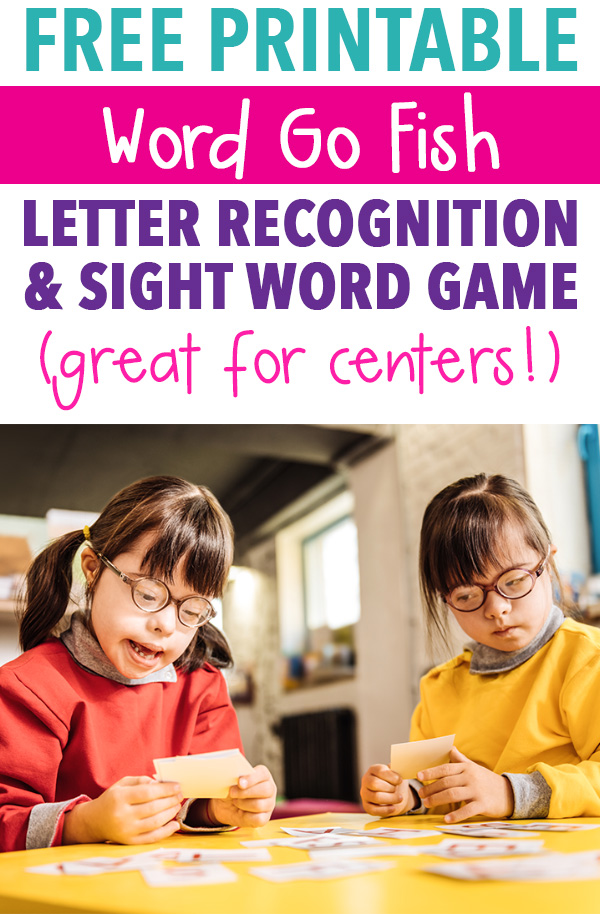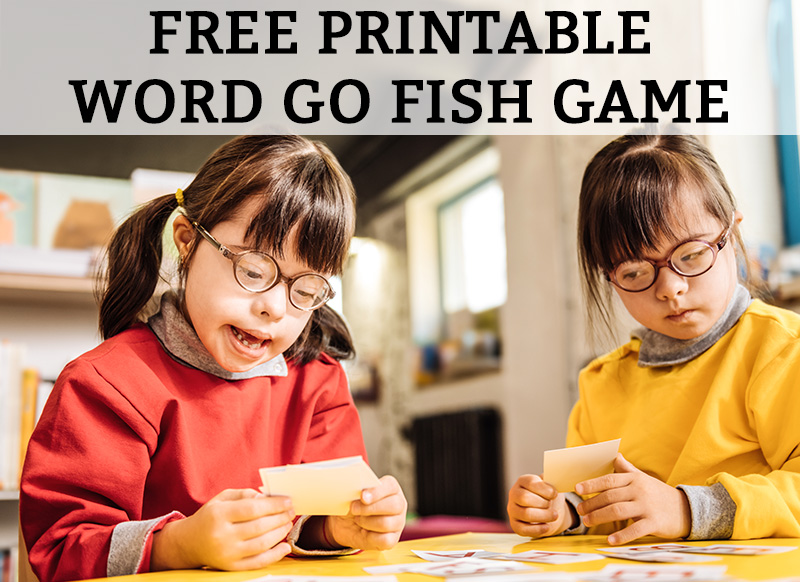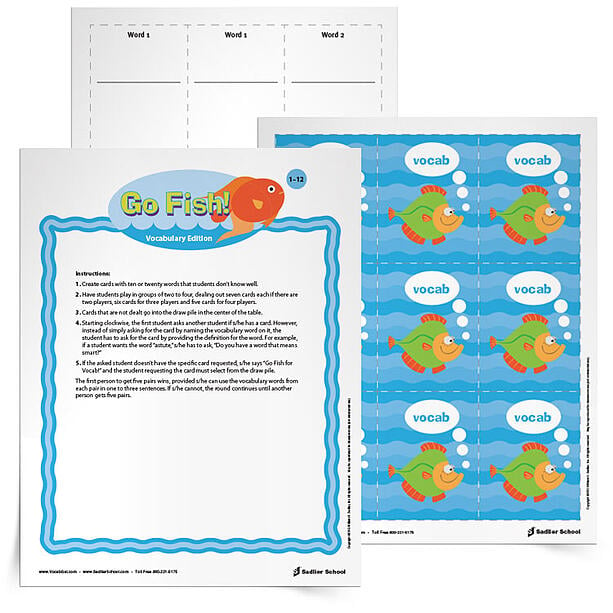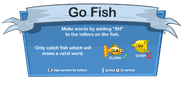- Overview
- Materials
- Activity
- Confidence Builder
- Assessment
- Printable Go Fish Cards
- Questions and Answers
1. Overview
Sight Words Go Fish is a vocabulary-themed variation of the classic Go Fish card game, for 2-4 players. Introducing this game is easiest when the children already have experience playing the traditional Go Fish game, because they will already understand the game dynamics and can focus their attention on the reading aspect. This is of particular importance for younger children, who can get overwhelmed with having to learn a new game and new words at the same time.
The goal is to collect more pairs of matching cards than anyone else. Children must read the sight word on the card they wish to play and be able to read the words that are requested by other players. It is another fun way to give children extensive exposure to a variety of sight words.
Image: Sight Words Go Fish
↑ Top
2. Materials
For Sight Words Go Fish, you will make and use a set of cards with various word pairs. The number of pairs depends on how many words you select when creating the cards. You can also remove some pairs from your deck of cards to make it a more manageable size.
Use our Go Fish Card Generator to create a set of cards and print them out, preferably on heavy-duty cardstock paper. You will want to use a mix of newer words that the children have not yet mastered and familiar words that could use some review.
↑ Top
3. Activity
These instructions are for a game with 3-4 players. Sight Words Go Fish can also be played easily with just two players.
Video: How to Play Sight Words Go Fish
Deal 5 cards to each player (7 cards each if there are only 2 players), then place the remaining cards face down in the middle of the circle formed by the players. All the players look at their cards but do not reveal them to each other.
Player A takes the first turn. Player A selects one of her cards and reads the word on it out loud, moving her index finger from left to right underneath the letters as she reads. (An adult should demonstrate this reading technique at the start of the game to teach or remind children how best to read the word.)
Player A then selects another player and asks him, “Player C, do you have any cards with the word BEFORE?” If Player C has a card with that word, he must say “Yes, I have a card with the word BEFORE,” and hand it to Player A, who then gets another turn. If any player struggles with reading or pronouncing a word, take a moment to go through the sight words correction to reinforce the correct pronunciation.
If Player C does not have any of the requested card, he shouts, “Go Fish!” Player A must then draw a card from the stack. If the drawn card has the word she was looking for, she shows the card and gets to take another turn. Otherwise, her turn ends, and the child who said “Go Fish” gets the next turn.
If a player collects both cards of a particular word pair, he puts them in a face-up stack in front of him. The game continues until someone has no cards left or the face-down stack runs out. The winner is the player with the most pairs of matching cards.
↑ Top
4. Confidence Builder
To make the game a little easier, especially for a younger child, simply use fewer pairs of cards.
↑ Top
5. Assessment
Observe the game, whether it’s watching your own child in your 2-player game or observing a group of students in a 4-player game. Make note of which words the children have mastered, and which ones are still a bit of a struggle. Be on the lookout for individual children who are struggling with several of the words.
A child is considered to have mastered the sight words in this activity when she can consistently recognize and read all the word cards in her hand, with confidence and without any noticeable hesitation.
↑ Top
6. Printable Go Fish Cards
Create your own custom Go Fish Cards or use some of our pre-made templates below.
To download a template, right-click and select Save As.
These materials are provided under the Creative Commons Attribution 3.0 Unported License. Essentially, this means you can do whatever you want with the resources, provided you leave the attribution hallmark on the resources. You may use these materials in the classroom, at home, as part of a for-profit tutoring business, or for any other purpose. (Except starting forest fires. That’s bad.) You do not need to contact us for permission to use the materials. We want you to use them!
↑ Top
Leave a Reply
Recent Blog Posts

Case Wars: Upper vs. Lower Case Letters
September 27, 2016
Some of our visitors ask us why all our materials are printed in lower-case letters as opposed to upper-case letters. We know that many preschool and kindergarten teachers focus on teaching upper-case letters first. The ability to recognize lower-case letters … Continued

Is It Dyslexia?
August 29, 2016
We sometimes get questions from SightWords.com visitors who are concerned that their child or grandchild may have a learning disability. Of particular concern is the possibility that their child might have dyslexia. Many people assume that dyslexia is a visual … Continued

SightWords.com at the Southeast Homeschool Expo
August 10, 2016
On July 29th and 30th, board members of the Georgia Preschool Association met at the Cobb Galleria Centre just outside Atlanta to attend the Southeast Homeschool Expo, a convention for homeschooling families and resource providers from across the Southeastern U.S. … Continued
© 2023 Sight Words: Teach Your Child to Read
Go Fish Word Match Game WorksheetsHigh Frequency Words for First GradeThis High Frequency Word Game is a Go Fish match game that uses high frequency words instead of playing cards. You can create up to a maximum of 168 double word sets from 128 preselected and 40 user entered words. You can do any combination of selecting for the list and/or entering your own words. Make sure you create enough words for each child to start with five cards and have 30 or more cards in the draw pile. Just play Go Fish with whatever rules or variations you wish to play. You may require the child to call out and spell the word for the request. Tip: Print these out on heavier paper or laminate them for longer use.
|
|
Word Go Fish is a simple game I created for centers years ago. It uses sight word cards in a game of Go Fish.
In addition to playing Word Fish with the cards, I also use the same cards for Memory. It’s a versatile game that you can print once and use in two different ways.
What’s Included?
- Direction cards
- Blank cards
- Preprimer cards
- Primer cards
- First-grade cards
- Second-grade cards
- Third-grade cards
- Card backs
Tips for Playing Word Go Fish or Word Memory
- Create some sort of back for the cards. If not, the cards will be see-through. You can do this by:
- Printing memory card or word fish backs and then glue onto the back of each sight word card sheet and then cut out.
- OR just simply glue the printed pages onto pieces of cardstock or construction paper and then cut it out (just glue the whole sheet and then cut, it’s easier!)
- Print on cardstock for added durability
- Laminate the cards so they last longer
- Send the files home with a parent or have a parent volunteer in school make them!
Materials Needed to Play Word Go Fish & Memory
- 2 copies of your level’s sight words cards per group of students (they need to make matches in both games so you will need 2 copies to make a match).
- 1 copy of directions per center
Word Go Fish Directions
2-4 players per game
- Deal 5 cards to each player
- Place the remaining cards facedown in a pile
- Player 1 asks another player if they have a matching card to one in their hand
- If the player has the requested card, they give it to player 1. This makes a pair and the player puts the pair down in their pair pile.
- If the player doesn’t have the card, they say “Word Fish” and player 1 takes a card from the pile and places it in their hand. If it makes a pair, they can put the pair into their pair pile.
- Repeat the process for each player.
- When there are no cards left in the deck, the player with the most pairs wins!
Sight Word Memory Directions
2-4 players per game
- Shuffle the cards.
- Lay all of the cards facedown in rows.
- Player 1 flips 2 cards over.
- If they make a match, they keep the cards and put them into a pile.
- If they don’t match, flip the cards back over.
- Repeat with the remaining players.
- When there are no cards left, the player with the most pairs wins!
Word Fish Directions
Memory Directions
Word Fish Backs
Memory Backs
Blank Sight Word Card (customize with your own sight words)
Pre-primer Dolch Cards (preschool/kindergarten)
Primer Dolch Cards (kindergarten)
First Grade Dolch Cards
Second Grade Dolch Cards
Third Grade Dolch Cards


By Kevin Fabris
August 15, 2016
10 — 15 Minutes, Answer, Card Game, Easy ESL Games, easyeslgames.com, EFL, ESL, Fun, Game, Games, Guessing Game, High School, Learn It, Materials Required, Memory, Practice It, Question, Small Class, Some Materials Required, Speaking, Young Learner
ESL Games are the most effective in kids classes when they are easy to play and don’t rely on a lot of teacher-talking-time. Go Fish is an excellent game that lets your ESL students start using English almost immediately.
- The only materials needed are a deck of cards. In the version pictured I’m using a deck of “Go Fish” cards (available on Amazon or wherever you buy toys) but a regular deck of playing cards works just as well.
- Go fish is ideal for between 3 and 6 players. If you have a larger class you can use multiple decks and have a few games going at the same time.
- Go Fish is perfectly suited for student’s between the ages of 6 and 10 but works great with any beginner level adult class as well.
The target language being used is “Do you have number, color fish?” E.g. “Do you have 6, pink fish?” The answer depending on whether or not the student has the specified card is is either “Yes, I do.” or “No, I don’t.“
The Objective:
In a game of Go Fish players are supposed to try and make pairs. When the game is finished every card should have found it’s match. The student that has the most pairs of cards is the winner.
How to:
- Go through your deck of cards and make sure each card has a matching card. In the picture to the right there are two matching cards each having 2 yellow fish on them. If you are using a regular deck of cards make sure there are two red 2s and two black 2s, two red 3s and two black 3s, etc.
- Shuffle and deal the deck of cards evenly between all players.
- Players go through the cards they’ve been dealt and remove any pairs they have. These pairs will count as points later so make sure your ESL students are putting the pairs down directly in-front of themselves and not into a group pile the middle of the game.
- As your students are putting their cards down they have to say “I have number, color fish.” E.g. “I have two, yellow fish.”
- Next, you start playing the ESL game. Each player is looking for the match to each of their cards. The first player in rotation will pick another player and ask for cards by using the other student’s name e.g. “John. Do you have 5, green fish?”
- If John has the 5, green fish card he passes it to the questioner and says “Yes, I do.” If John doesn’t have the 5, green fish card he says “No, I don’t.”
- Rotate around the circle of players repeating steps 5 – 6 until every card has found it’s match.
- At the end of the game the player in possession of the most pairs of cards is the winner.
This version of the game makes sure students learned and practiced “I have _____?” and “Do you have _________?” as well as the appropriate answers “Yes, I do.” and “No, I don’t.“
You can adapt this game to varying levels of difficulty. The simplest version I use is strictly for counting and the target language is “Number fish, please.“
Some of the more difficult language targets you can use are “(persons name), may I have number, color fish please?” or “(persons name), could you please pass me number, color fish?”
Like all games, have fun with it. Tailor it to meet the language needs of your learners. Most importantly,
Enjoy!
Watch more here:
January 5, 2015
A-Z Race
This is a fun ESL game that can
May 31, 2020
Simon
This is a simple twist on the classic
November 2, 2016
Routines
The Details about Routines:The only materials required are
November 17, 2016
Monster Game
This Super Simple Game submission comes from Olga.
January 1, 2015
Shiritori
Shiritori is a classic ESL game. You might
Worksheets
Powerpoints
Video Lessons
Search
Filters
SORT BY
Most popular
TIME PERIOD
All-time
Nanou59
74242 uses
1mada
18570 uses
1mada
18268 uses
mewi
9104 uses
mariemarron
8281 uses
1mada
6725 uses
Lili27
5244 uses
Lili27
5157 uses
Lili27
4848 uses
Lili27
4679 uses
1mada
3726 uses
Lili27
3515 uses
Next
6
Blog
FAQ
About us
Terms of use
Your Copyright
Today I’m sharing a fun, relatively quick vocabulary game that helps students master a few of their trickier vocabulary words! The idea came to me when perusing official decks of Go Fish playing cards. There was a Garfield version, a Wilderness version, and I can imagine that there are many more versions on the market!
However, I’m not sure if there has been a vocabulary version of Go Fish… until now! Have students Go Fish for vocabulary words with my Go Fish Vocabulary Game.
- Create cards with ten or twenty words that students don’t know well.
-
Have students play in groups of two to four, dealing out seven cards each if there are two players, six cards for three players and five cards for four players.
-
Cards that are not dealt go into the draw pile in the center of the table.
-
Starting clockwise, the first student asks another student if s/he has a card. However, instead of simply asking for the card by naming the vocabulary word on it, the student has to ask for the card by providing the definition for the word. For example, if a student wants the word “astute,” s/he has to ask, “Do you have a word that means smart?”
-
If the asked student doesn’t have the specific card requested, s/he says “Go Fish for Vocab!” and the student requesting the card must select from the draw pile.
The first person to get five pairs wins, provided s/he can use the vocabulary words from each pair in one to three sentences. If s/he cannot, the round continues until another person gets five pairs.
To ensure your Go Fish Vocabulary Game works at any grade level, I’ve included two sets of Go Fish cards in my download. The first set of cards is for lower grade levels, and the second set is for upper grade levels.
Let me know how the game works out in your classroom. You can leave a comment or tweet me @vocabgal.
Common Core State Standards:
Language Standard 4. Determine of clarify the meaning of unknown words.
Language Standard 5. Demonstrate understanding of word relationships and nuances in word meaning.
Language Standard 6. Acquire and use accurately a range of general academic and domain-specific words and phrases; demonstrate independence in gathering vocabulary knowledge
*These are the rules as I’ve designed them but feel free to modify them as works best in your classroom.
About The Game
In Go Fish, you must make words by placing the letters «SH» after the letters on the swimming fish.
The mini-game lasts 20 seconds.
Scoring
| Correct Fish | +5 points |
|---|---|
| Incorrect Fish | -3 points |
Tips
Many players find that it helps to shout words out as they play. Expect cries of «plush», «brush» and «plosh» during gameplay from both novices and experienced players!
Screenshots
Instructions
Community content is available under CC-BY-SA unless otherwise noted.
Tags: alphabet, animals, beginner, classroom objects, home, jobs, kids, numbers, some/any
The Go Fish ESL game is a version of the classic card game, in which students have to get four numbers/vocabulary items of the same type.
2+
10-20+ mins
Playing Cards or Card and Coloured Pens/Pencils
Setup
Students will play this game in groups of four or five (or two or three with a very small class). You will need a set of playing cards for group.
For practising numbers, these cards can be a set of traditional playing cards (skip the next step). If you wish to practise a different type of vocabulary, you will need to make your own cards with the help of your class. This option is designed for kids classes.
To make sure all the cards are the same size, cut some pieces of card into equal sized rectangles beforehand (one set will require at least 40 cards). Each student should then make one card for each vocabulary item (e.g. for animals, a pig , a cat, a monkey…) by writing the word and drawing a small picture.
To make a complete set you will need at least ten different vocabulary items, and four cards for each vocabulary item. The students in a group can combine the cards they have made to make a complete set.
Game
- Each group sits in a circle, with one set of cards.
- The cards are shuffled then dealt so that each student has five cards (seven in a group of two or three). The rest of the cards are placed face down in the middle.
- Students take turns playing. On their turn, a student asks any other person if they have a particular type of card (fours, pigs etc.). If that person has that type of card, they have to give it to the asker. Otherwise, they say “Go Fish”, and the asker takes a card from the middle.
- If a student receives one or more of the cards that they ask for (either from another player or the middle), their turn continues. Otherwise, play passes to the student to the left.
- If at any point a student holds four cards of the same type, they must place this set face up in front of them. Each complete set is worth one point.
- Play continues until all sets are complete, and the student with the most points at the end wins.
Target Language
The Go Fish ESL game is most commonly played to practise numbers. However, if you make your own cards, you could practise almost type of vocabulary. As the game is only suitable for beginners, this vocabulary is usually limited to the alphabet, animals, jobs, classroom objects and household objects.
It can also be useful practice for the correct use of some and any. In this case, make sure students use these words in both questions and answers (including before “Go Fish”). For example, Do you have any fours? Yes I’ve got some fours / No I haven’t got any fours – Go Fish!
Got a picture or video of this activity in action? How about snapping one next time you use it? We’d love to showcase your submissions- find out more here.

















